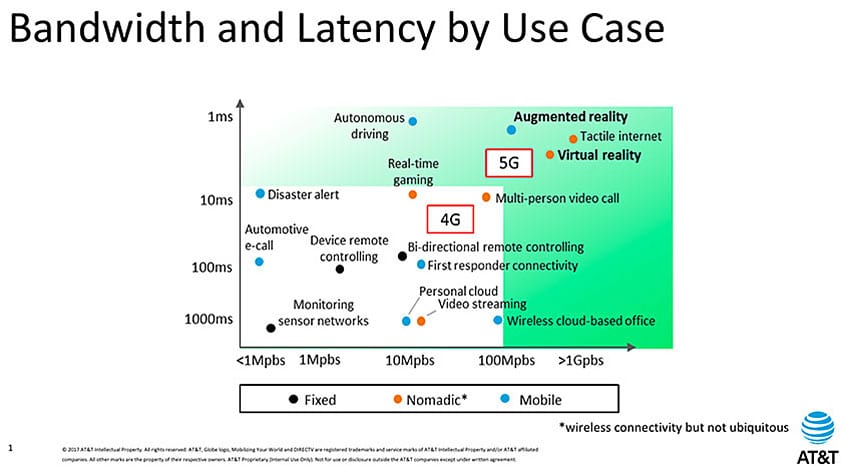AT&Ts Perspective on Edge Computing from Fog World Congress
Introduction:
In her October 31st keynote at the Fog World Congress, Alicia Abella, PhD and Vice President – Advanced Technology Realization at AT&T, discussed the implications of edge computing (EC) for network service providers, emphasizing that it will make the business case for 5G realizable when low latency is essential for real time applications (see illustration below).
The important trends and key drivers for edge computing were described along with AT&T’s perspective of its “open network” edge computing architecture emphasizing open source software modules.
Author’s Note: Ms. Abella did not distinguish between edge and fog computing nor did she even mention the latter term during her talk. We tried to address definitions and fog network architecture in this post. An earlier blog post quoted AT&T as being “all in” for edge computing to address low latency next generation applications.
………………………………………………………………………………………………………………..
AT&T Presentation Highlights:
- Ms. Abella defined EC as the placement of processing and storage resources at the perimeter of a service provider’s network in order to deliver low latency applications to customers. That’s consistent with the accepted definition.
“Edge compute is the next step in getting more out of our network, and we are busy putting together an edge computing (network) architecture,” she said.
- “5G-like” applications will be the anchor tenant for network provider’s EC strategy. augmented reality/virtual reality, Multi-person real time video conferencing, and autonomous vehicles were a few applications cited in the illustration below:
Above illustration courtesy of AT&T.
“Size, location, configuration of EC resources will vary, depending on capacity demand and use cases,” said Ms. Abella.
…………………………………………………………………………………………………………..
- Benefits of EC to network service providers include:
- Reduce backhaul traffic
- Maintain quality of experience for customers
- Reduce cost by decomposing and disaggregating access function
- Optimize current central office infrastructure
- Improve reliability of the network by distributing content between the edge and centralized data centers
- Deliver innovative services not possible without edge compute, e.g. Industrial IoT autonomous vehicles, smart cities, etc
“In order to achieve some of the latency requirements of these [5G applications?] services a service provider needs to place IT resources at the edge of the network. Especially, when looking at autonomous vehicles where you have mission critical safety requirements. When we think about the edge, we’re looking at being able to serve these low latency requirements for those [real time] applications.”
- AT&T has “opened our network” to enable new services and reduce operational costs. The key attributes are the following:
- Modular architecture
- Robust network APIs
- Policy management
- Shared infrastructure for simplification and scaling
- Network Automation platform achieved using INDIGO on top of ONAP
- AT&T will offer increased network value and adaptability as traffic volumes change:
- Cost/performance leadership
- Improved speed to innovation
- Industry leading security, performance, reliability
“We are busy thinking about and putting together what that edge compute architecture would look like. It’s being driven by the need for low latency.”
In terms of where, physically, edge computing and storage is located:
“It depends on the use case. We have to be flexible when defining this edge compute architecture. There’s a lot of variables and a lot of constraints. We’re actually looking at optimization methods. We want to deploy edge compute nodes in mobile data centers, in buildings, at customers’ locations and in our central offices. Where it will be depends on where there is demand, where we have spectrum, we are developing methods for optimizing the locations. We want to be able to place those nodes in a place that will minimize cost to us (AT&T), while maintaining quality of experience. Size, location and configuration is going to depend on capacity demand and the use cases,” Alicia said.
- Optimization of EC processing to meet latency constraints may require GPUs and FPGAs in additional to conventional microprocessors. One such application cite was running video analytics for surveillance cameras.
- Real time control of autonomous vehicles would require a significant investment in roadside IT infrastructure but have an uncertain return-on-investment. AT&T now has 12 million smart cars on its network, a number growing by a million per quarter.
- We need to support different connectivity to the core network and use “SDN” within the site.
- Device empowerment at the edge must consider that while mobile devices (e.g. smart phones and tablets) are capable of executing complex tasks, they have been held back by battery life and low power requirements.
- Device complexity means higher cost to manufacturers and consumers.
- Future of EC may include “crowd sourcing computing power in your pocket.” The concept here is to distribute the computation needed over many people’s mobile devices and compensate them via Bitcoin, other crypto currency or asset class. Block chain may play a role here.
One thought on “AT&Ts Perspective on Edge Computing from Fog World Congress”
Comments are closed.




After her talk, I asked Alicia what AT&T means when they use the term “Software Defined Network.” That’s because many of AT&Ts so called SDNs did not follow the accepted definition (separate control and data planes, standardized interface between them, centralized routing/path selection, etc).
Alicia said that SDN for AT&T was software control of its network. I pointed out that AT&T promoted that almost 30 years ago with their software defined “intelligent network” based on common channel signalling system 7. “Everything old is new again?” Or is SDN an instance of old is the new “new?”